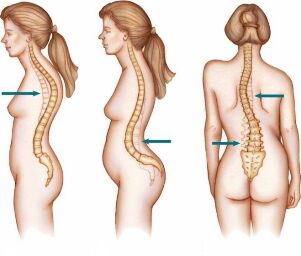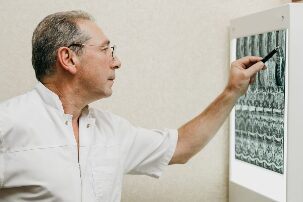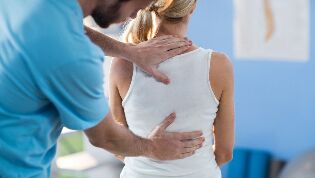Back pain is one of the most common complaints among people over the age of 25-30. They can act not only as a result of overwork, but also as a symptom of diseases of the spine or internal organs. Therefore, it is important to pay attention to your health and ignore the problem. After all, if back pain occurs with pathological changes in the spine, it can lead to serious complications and even disability.

Reasons
In some cases, the back hurts for natural reasons: after physical activity, heavy exercise, long walks in high heels, etc. muscles, twists. Therefore, it is necessary to give a few days of back rest to eliminate them.
Pregnancy is a common cause of back pain. As the body undergoes many changes, especially in the later stages of pregnancy, it may respond with back pain. If it is not acute and is not associated with discomfort in the abdomen or the appearance of abnormal discharge, this is considered a normal option. However, changes that occur at the same time, a change in the center of gravity and a woman's weight gain during pregnancy can lead to exacerbation of chronic diseases or the development of degenerative-dystrophic changes in the spine.
It is very important to tidy up the spine during pregnancy due to the doubling of the load on a woman's body. Our clinic has developed and prepared a comprehensive examination and treatment program for pregnant women and those planning a pregnancy.
Degenerative-dystrophic processes and other pathologies of the spine that cause back pain in women and men over 30 years of age. Along with them, the pain can be localized in any part of the lower back (neck, between the shoulder blades, in the lumbar region) and can affect the head, shoulders, arms, thighs, legs, etc. Verin. It can be of varying degrees, sharp, shooting, pulling, painful, always ready, or occur after physical exertion. All of these are important signs that help determine the cause of the development of pain syndrome and therefore find an effective way to eliminate it.
The most common diseases associated with back pain are:
- osteochondrosis, protrusions and intervertebral hernias;
- curvature of the spine (kyphosis, scoliosis, lordosis and their combinations);
- myofascial syndrome.
A little less common back pain is caused by compression fractures of the spine (typical for people who are elderly or injured, falling from heights, having an accident), ankylosing spondylitis, spondylosis, spondylolisthesis and other diseases of the spine.
In addition, pain in various parts of the lower back can lead to disorders of the internal organs. For example, pain in the neck may indicate pathology of the thyroid gland, inflammation of the lymph nodes, vascular disease, and back pain may indicate pathology of the kidneys, pelvic organs, and gastrointestinal tract. In the middle of the back, in the area of the shoulder blades, discomfort is very rare and occurs at the same time. Appearance in addition to spinal diseases in the formation of disorders of the heart, etc. Can be.
But the essence of the problem is that no disease of the internal organs is visible. They are almost always the result of a violation of segmental innervation, ie the quality of transmission of nerve impulses from the spinal cord through nerve roots and nerve branches to specific organs. Each level of the spinal cord corresponds to its own pair of spinal roots, where the nerves leading to the relevant organs are branched. If there are changes in the spine, such as curvature, displacement of the vertebrae, changes in the height and position of the intervertebral discs, it inevitably affects the condition of the spinal cord and spinal cord. Because they change their natural parameters and positions, they can be compressed or even injured by various vertebral structures. Therefore, nerve impulses pass worse to the organs, which leads to the emergence of initially insignificant, but persistent progressive disorders in their work. Gradually, organic changes occur in the organs, which leads to the development of the disease. Therefore, in case of detection of back pain and pathologies of the internal organs, it is important to examine the spine and find the changes that lead to its development. Exposure to them will increase the effectiveness of treatment of internal diseases and, most importantly, eliminate the preconditions for their occurrence.
Each spinal movement segment has its own pair of nerve roots that transmit signals to a specific organ.
Osteochondrosis, protrusion and intervertebral hernia
Osteochondrosis is the most common spinal disease in every second adult at different stages of development. It is accompanied by degenerative-dystrophic changes in the intervertebral discs, ie their gradual destruction.
It differs in which part of the back pain occurs and therefore in the degenerative-dystrophic processes in the intervertebral discs, cervical, thoracic and lumbar osteochondrosis. Most often, the lumbosacral spinal disc, a little less - the cervix is destroyed, and only rarely is osteochondrosis of the thoracic spine diagnosed.
Pain is typical for osteochondrosis, initially mild, painful after physical exertion or prolonged sitting. They gradually intensify and occur more and more often. Over time, the discs become so depleted that they do not withstand the loads placed on their outer shells and become deformed, resulting in a protrusion that turns into a tear. In the latter case, the ring fibrosis is completely torn and the inner contents of the disc can fall into the spinal canal.
In both cases, the protruding parts can cause radicular syndrome by squeezing the spinal roots. This means that in addition to the pain being sharp and intense, the arms, legs, hips and other parts of the body will also be given, depending on which disc is deformed. Thus, when the cervical spinal nerves are constricted, the pain is transmitted to the shoulders and arms, and when the lumbar nerves are constricted, to the thighs and legs. This is often accompanied by sensitive disorders, including numbness, crawling sensations, and gradual muscle atrophy.
The disease is fraught with irreversible changes in nerve fibers that can lead to paralysis and disability.
Spinal curvature
The curvature of the spine can be observed in any part of it. Today, a perfectly straight spine is a rarity, so a more or less obvious deformity is present in almost every modern person. It can be:
- kyphosis - strengthening the natural curvature of the spine in the cervicothoracic region;
- lordosis - increased natural deviation of the lumbar region in the lumbar region;
- scoliosis - lateral deformity of the spine.
In each case, the curvature can lead to compression of different nerve groups, which will lead to radical syndrome. However, if changes in the early stages of development with osteochondrosis cannot be visualized, spinal deformities can be easily diagnosed with asymmetry of the shoulder blades, pelvis, abdomen, or the formation of a stump.

Myofascial Syndrome Myofascial syndrome is not a dangerous but painful condition in which certain muscle groups spasm in response to pressure or physical activity. Therefore, against a background of completely normal health, if you step on the place where back pain generally occurs, you can get a new acute pain attack, which is an important diagnostic criterion.
Diagnosis of back pain
If back pain occurs in the neck, between the shoulder blades, or in the lumbar region, it is recommended that you consult a neurologist. If the pain spreads to other parts of the body, you should see a chiropractor, vertebrologist and neurologist as soon as possible, as this is a sign of the development of radical syndrome.
The specialists of our center apply an integrated approach to diagnosis and treatment, thus making a correct diagnosis as soon as possible. Diagnosis begins with a survey of the patient, during which the nature of the complaints, as well as the characteristics of work and rest are clarified. The doctor should carefully examine the patient, palpate the spine, as well as perform special functional and neurological tests. This allows you to form a comprehensive picture of the patient's condition, detect signs of neurological deficits and assess the degree of damage. To clarify the diagnosis, it is necessary to determine the following:
- X-ray examination;
- CT;
- MRI.

If there are no contraindications, MRI is always preferred because this method can provide the most complete information about the condition of the spine and especially the discs, which intervenes in the early stages of diagnosis and timely pathological process of small changes in their condition. allows you to do.
In our clinic you can learn more about the composition of the body and the condition of the vascular system, which is involved in the blood supply to the internal organs, musculoskeletal muscles and brain. Our experienced doctors will explain the findings to you in detail. Bioimpedansometry calculates the ratio of fat, muscle, bone and skeletal mass, total body fluid, basal metabolism. The intensity of recommended physical activity depends on the condition of the muscle mass. Metabolic processes, in turn, affect the body's ability to recover. According to the indicators of active cell mass, the level of physical activity and nutritional balance can be assessed. This simple and quick test helps us to see and take action on endocrine disorders. In addition, it is very important for us to know the condition of blood vessels to prevent diseases such as heart attack, hypertension, heart failure, diabetes and more. Angioscan allows you to determine important indicators such as the biological age of the arteries, stiffness, stress index (speaking of heart rate), blood oxygen saturation. Such an examination will be useful for men and women over 30 years of age, athletes, those who have undergone long and difficult treatment, as well as anyone who monitors their health.
If the diagnosis shows that back pain is the result of the development of diseases of the internal organs, the patient should be referred to a urologist, endocrinologist, gynecologist, gastroenterologist, cardiologist, etc. are applied to narrow specialists such as.
Body composition analysis tells us how much fat tissue and musculoskeletal components are in the body. This information will help the rehabilitator to plan the physical activity correctly, taking into account the individual characteristics of the patient.
Back Pain Treatment
Treatment of low back pain is always complicated, because pathological changes in the spine can not be eliminated by medication alone. At the same time, the therapy regimen is developed individually for each patient. Not only the diagnosis and stage of development of the disease, but also the presence of co-morbidities, the patient's age, work habits and characteristics, level of physical fitness and other factors are taken into account. Therefore, in patients with the same diagnosis, such treatment can be carried out in different ways. Only this approach gives maximum results.
Thus, the main components of conservative therapy for low back pain of vertebrogenic origin are:
- drug treatment;
- osteopathy;
- manual treatment;
- massage;
- physiotherapy (phonophoresis, carboxytherapy, ozone therapy, pressotherapy RF currents);
- Individual lesson with a rehabilitation doctor.
Spinal surgery is indicated only in very advanced cases with the absolute ineffectiveness of conservative treatment.
Patients are advised to lose as much weight as possible, avoid excessive physical activity and sedentary lifestyle. A balanced diet will increase the effectiveness of treatment.

Drug treatment
Drug treatment can include drugs from different pharmacological groups, depending on a combination of different factors. In most cases, patients are prescribed the following:
- NSAIDs;
- corticosteroids;
- muscle relaxant;
- chondroprotectors;
- B vitamins;
- vitamin D.
Blockade may be offered to patients with very severe radical pain that cannot be treated with non-steroidal anti-inflammatory drugs or analgesics. The procedure sometimes involves injecting a solution of lidocaine or novocaine in combination with corticosteroids directly into the area where the compressed nerve passes. It has no therapeutic effect, but also allows you to quickly eliminate severe pain of neurological origin. However, the implementation of blockades requires special skills and absolute sterility, as such injections can lead to the development of serious complications.
Manual therapy
Manual therapy is rightly considered one of the main components of the treatment of low back pain of various origins, as it allows to restore the normal anatomy of the spine at the same time:
- increase the quality of transmission of nerve impulses along the peripheral nerves to all organs of the human body;
- activates blood circulation and lymph flow;
- to start the natural processes of the body's recovery and create favorable conditions for their flow;
- strengthens immunity and increases the body's ability to adapt to new living conditions, etc.
The use of special techniques that move the hand, especially in the spine and surrounding tissues, allows you to relieve pressure on the roots of various anatomical structures in the spinal cord, which leads to pain relief covering the limbs and other parts of the body. In addition, they can increase the distance between the vertebral bodies, which provides the most favorable conditions for the recovery of deformed spinal discs, and active kneading of muscles helps to eliminate functional blocks, increase spinal mobility and elasticity and speed up metabolic processes.

We do not have general treatment standards, individual approach is applied to each patient. Gritsenko's author's technique has shown high efficiency over the years of use. It not only eliminates back pain, but also has a special effect on the spine, as the causes of their occurrence are eliminated. Normalization of the segmental innervation of the spinal cord helps to improve the functioning of internal organs and eliminate the causes of disease.
Thus, patients with low back pain, according to Gritsenko's author's method, can expect obvious positive changes after 1-2 times of manual therapy. How many procedures will be required to achieve the maximum possible result and consolidation is selected individually for each patient.
Physiotherapy
Physiotherapy is prescribed outside the acute phase of the disease. With its help it is possible to increase the effectiveness of other methods of influence. As a rule, patients are prescribed courses of procedure characterized by anti-inflammatory, analgesic, antispasmodic properties:
- electrophoresis;
- traction treatment (spinal traction);
- UHF;
- laser therapy;
- ultrasound therapy, etc.
exercise therapy
Physiotherapy is not the last component in the treatment of low back pain. The stability of the result depends mainly on the regularity and accuracy of its implementation, as exercise therapy is primarily aimed at strengthening the lumbar muscle corset, which will provide support for the spine and reduce the load on the intervertebral discs. In addition, exercise therapy helps to improve the quality of blood circulation, which leads to a more active supply of drugs and nutrients to the lesions, which increases the effectiveness of therapy.

However, it is not recommended that you choose a number of exercises for yourself, because generally performing the recommended exercises can harm the patient due to excessive tension of certain muscle groups. Therefore, the development of the optimal complex should be entrusted to a rehabilitation physician who will teach a person to perform each task correctly.
Thus, although back pain is familiar to every adult, it should not be considered harmless. Such negligence can result in serious complications and, at best, can be resolved surgically. In the worst case, the patient has a disability. Therefore, if back pain occurs with an enviable pattern or is very severe, consult a neurologist and find out the real cause of the discomfort. After all, it is very easy to stop the disease in the early stages of development.

























